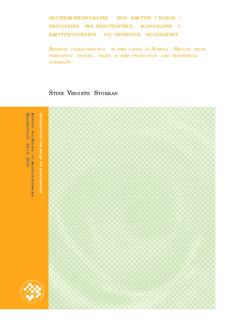| dc.description.abstract | Formålet med oppgaven var å analysere resultatene fra lineærkåringen i fenotypetesten på Staur for kjøttferasene Hereford, Simmental, Charolais, Limousin og Aberdeen Angus og vurdere effekten av alderen på dyret ved bedømningen på utvalgte eksteriøregenskaper og sentrale produksjonsegenskaper samt se på mulige virkninger på den teoretiske holdbarheten og levetiden i besetningen. Registreringer fra totalt 977 ungokser fra testomgangene i perioden 1999 til 2012 ble undersøkt for egenskapene total og daglig tilvekst, arealmål ryggmuskel, muskeldybde, fettdybde, intramuskulært fett samt eksteriøregenskapene samlepoeng helhet, overlinje, knokkelbygning, forstilling, hasestilling, hasevinkel og kodevinkel.
Registreringene fra fenotypetesten ble analysert i to ulike modeller, med effekt av alder ved bedømning og rase samt effekt av alder innen rase. Det ble funnet signifikante forskjeller i LS-Means for rasene for alle analyserte egenskaper. Alder ved bedømning har generelt en signifikant effekt på daglig tilvekst, arealmål ryggmuskel, muskeldybde, fettdybde samt alle eksteriørmålene i denne oppgaven. Modellen med effekt av både alder og rase forklarte en større del av variasjonen i de fleste egenskapene.
Endringene i eksteriøregenskapene som følge av en økt alder ved bedømning kan både telle positivt og negativt for den teoretiske holdbarheten og levetiden i besetningen.
De intensive kjøttferasene Charolais og Limousin viste en signifikant nedgang i daglig tilvekst med økt alder ved bedømning. Limousin hadde også en sterk, signifikant alderseffekt på innholdet av intramuskulært fett – rasen fikk markant større innhold av IMF. Modellen med effekt av alder innen rase forklarte 41,5 % av variasjonen i IMF hos Limousin.
Effekten av alder hos oksen ved bedømning bør tas nærmere i betraktning og kan studeres videre med blant annet data fra slakterier og produsenter som viser sammenhenger med faktisk kjøttkvalitet og dyrenes livslengde i besetningen. Alderen hos dyret kan eventuelt korrigeres for på en annen måte, et alternativ kan være rullerende inntak og fenotypetesting gjennom året som tilpasning til spredt kalving i besetningene.
The aim of this study was to investigate the results from the linear measurements of exterior characteristics as a part of the phenotypic testing at Staur. Results for the beef cattle breeds Hereford, Simmental, Charolais, Limousin and Aberdeen Angus was examined for the effect of the age of the bull by the time of testing, on selected exterior characteristics and key production traits and possible influences on the theoretical durability and stock lifetime.
Registrations from 977 bulls in total from the phenotypic tests in the period 1999-2012 was investigated for the production traits total and daily weight gain, area measure of back muscle, muscle depth, fat depth, intramuscular fat and the exterior traits overall impression, topline, bone structure, fore leg position, rear leg position, rear leg angle and foot angle.
The registrations were analyzed by two different models, the one with effects of age and breed, the other with effect of age within breed. It was detected significant differences in Least Square-means between breeds for all traits. The age of the bull by the test-time had significant effect on daily weight gain, area measure of back muscle, muscle- and fat depth in addition to all the exterior traits in this study. The model with effects of both age and breed explained more of the variation for most traits.
Changes in the exterior traits due to an increased age of the animal by the test-time can be both positive and negative for the theoretical durability and the life length of the animal in stock.
The continental beef breeds Charolais and Limousin showed significantly decreasing daily weight gain with increased age by test-time. Limousin also had a strong, significant effect on the content of intramuscular fat – which increased markedly. The model with effect of age within breed explained 41,5 % of the variation in the content of intramuscular fat in Limousin.
Influences of the age of the bull by test-time should be investigated further, for example with registrations from slaughter houses and farmers. This could show relationships with true beef quality and true life length of the animals. Methods to correct for the effect of age should be reviewed, in addition to some actions in adaption to increasingly spread calving – like more continuous intake of bulls and phenotypic testing the year through. | no_NO |
